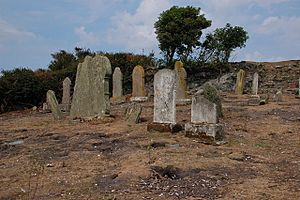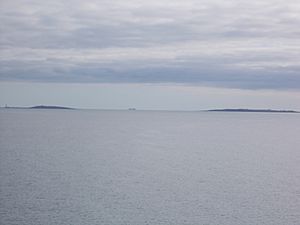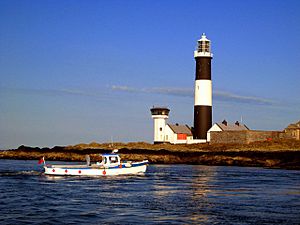Copeland Islands facts for kids
The Copeland Islands are a group of three small islands in the northern Irish Sea. They are located just north of Donaghadee in County Down, Northern Ireland. The three islands are called Lighthouse Island (also known as Old Island), Copeland Island (also known as Big Island), and Mew Island. These islands are part of the civil parish of Bangor.
The Copeland Islands are special because they are among the very few islands on Ireland's east coast that have been lived on at some point. Other examples include Lambay Island and Ireland's Eye near County Dublin.
Contents
What's in a Name?
The name "Copeland Islands" probably comes from the de Coupland family. This family were Normans who settled in the Newtownards area in the 1100s. Other places nearby, like Copeland Water near Carrickfergus and Ballycopeland, also got their names from this family.
However, the islands might have had an even older name! Around the year 1230, in an old Norse story called Hakonar Saga Gamla, the islands might have been called Kaupmanneyjar. In Old Norse, kaupmann means 'merchant' and ey means 'island'. Some people think 'Kaupmann' slowly changed into 'Copman' and then into 'Copeland'.
We don't know the original Irish name for the islands. Today, the Irish name is Oileáin Chóplainn, which is just the Irish way of saying "Copeland Islands".
Island History
The Copeland Islands include three main islands: Big Island (or Copeland Island), Lighthouse Island (or Old Island), and Mew Island. A long time ago, Lighthouse Island had about 100 people living there, including a school with 28 students.
In 1715, a light beacon was set up on Lighthouse Island to help guide ships. This beacon burned a lot of coal every year! Later, in 1813, a proper lighthouse was built there. But in 1884, a new lighthouse was built on Mew Island instead. The old lighthouse on Lighthouse Island stopped working.
For many years, until the 1900s, the islands were used by smugglers. They would bring things like tobacco and spirits through the islands and into County Down.
In 1954, a special place for studying birds, called the Bird Observatory, was started by Arnold Bennington.
Special Nature Area (ASSI)
The Copeland Islands are a special place for nature, known as an Area of Special Scientific Interest (ASSI). This means they are protected because they are very important for wildlife. The ASSI includes Big Copeland, Lighthouse Island, and Mew Island.
These islands are important homes for many seabirds and waders (birds that wade in water). They also have interesting coastal plants and unique geological features (rocks and landforms).
Big Copeland has the most different types of natural areas. Near the sea, you can find plants that like salty conditions. There are also cliffs with special plants and small areas of salt marsh. The middle of the island has wet grasslands and marshy areas.
Island Plants (Flora)
Lighthouse Island has short grass, which is often eaten by rabbits. It also has large areas of bracken (a type of fern) and Himalayan balsam (a tall plant with pink flowers). Some special plants found here include English stonecrop, rock sea-spurrey, Scots lovage, and sea purslane.
It's interesting that Lighthouse Island is the most southern place in Europe where Scots lovage grows. It's also the most northern place in Ireland where sea purslane grows! Other plants on the islands include bluebells, Spanish bluebells, northern marsh orchids, and common centaury.
Mew Island mostly has tall grasses and bracken. But like the other islands, it has important areas of rocks and places where the tide goes in and out.
Seaweed (Algae)
Scientists studied the seaweed around Lighthouse Island and Mew Island in 1975. They found and listed 56 different types of marine algae.
Lichens
In 1984, nineteen different types of lichens were found on Lighthouse Island. Lichens are like a mix of fungus and algae that grow on rocks and trees. These are the only known records of lichens from Lighthouse Island.
Island Animals (Fauna)
The Copeland Islands are super important for certain birds that breed there. They are a globally important place for Manx shearwaters and Arctic terns. They are also nationally important for Mediterranean gulls, common gulls, and eider ducks.
The Manx shearwater colony on the Copeland Islands is huge, with over 4,000 pairs of birds. This is more than 1.7% of all the Manx shearwaters in the world! The rabbits on the islands are very helpful to the shearwaters. The shearwaters often nest in the rabbit burrows (tunnels). Also, the rabbits keep the grass short, which is good for the young birds when they are learning to fly.
Great Copeland has a very important colony of Arctic terns, with about 550 pairs. This is now the biggest colony of Arctic terns in Ireland. Mew Island used to be important for terns, and people hope they will come back with good management.
The islands are also the most important breeding sites in Northern Ireland for common gulls, with over 250 pairs. Recently, Big Copeland had the first successful breeding pair of Mediterranean gulls in Northern Ireland! The islands are also home to many breeding eider ducks, making up 14% of Ireland's total population.
Other birds that breed here include black guillemots, water rails, and stock doves. Stock doves have become rare in Northern Ireland, but their numbers have grown on Copeland, with about 100 pairs now breeding. Wading birds like lapwings and snipe can be found further inland.
After the breeding season, birds of prey like Hen harriers, sparrowhawks, buzzards, kestrels, merlins, and peregrine falcons are often seen on the islands.
Many mammals have been seen around the Copeland Islands. These include grey seals, common seals, harbour porpoises, bottlenose dolphins, minke whales, common dolphins, and otters.
Scientists have also recorded many insects. There are 19 types of butterflies, 31 types of large moths, and three types of small moths. In 2013, a new type of beetle for Northern Ireland, called Diplapion confluens, was found here.
Island Lighthouses
A light station was first set up on Lighthouse Island in the early 1700s, and a lighthouse was built in 1815. This lighthouse stopped working in 1884 when the Mew Island Lighthouse took over. Today, you can still see the ruined stone tower of the old lighthouse. The old keeper's house has been rebuilt and is now used by the Copeland Bird Observatory. The National Trust owns the island.
The Mew Island Lighthouse is still working today. It became automatic in 1996, meaning lighthouse keepers no longer live there.
Princess Victoria Ferry Disaster
On January 31, 1953, a ferry called the Princess Victoria sank near the Copeland Islands. The ferry was traveling from Stranraer to Larne when it got caught in a very bad storm. Sadly, 133 people lost their lives in this accident.
See also
 In Spanish: Islas Copeland para niños
In Spanish: Islas Copeland para niños




